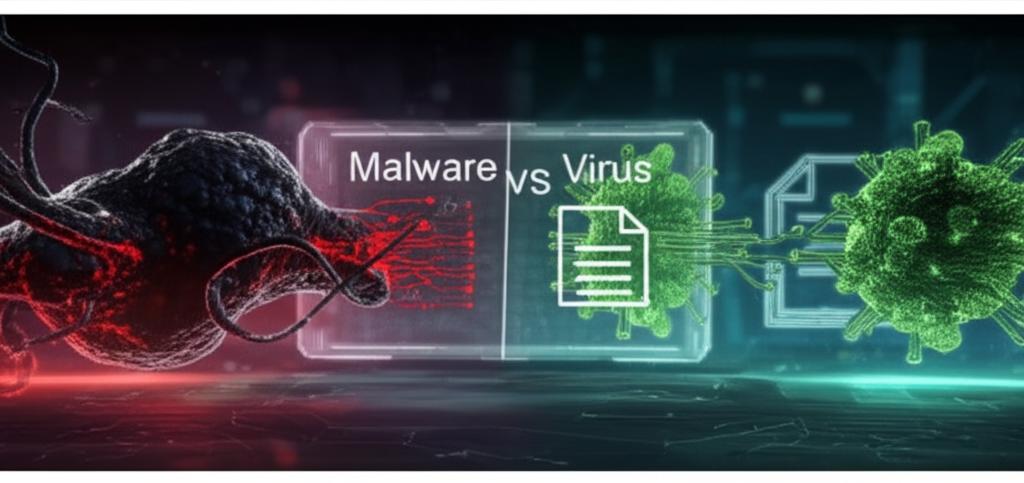Demystifying the Dangerous Divide: Malware vs Virus Explained
Understanding the Crucial Distinction: Malware vs. Virus
In the evolving landscape of digital threats, terms like ‘malware’ and ‘virus’ are often used interchangeably, leading to confusion. While closely related, they are not the same. Grasping the fundamental differences is paramount for effective cybersecurity. This guide will clarify the relationship, characteristics, and implications of these digital dangers.
What is Malware? The Umbrella Term
Malware, a portmanteau for ‘malicious software,’ is an overarching term for any software intentionally designed to cause damage to a computer, server, client, or computer network, or to gain unauthorized access to data or a system. It encompasses a vast array of hostile, intrusive, or annoying programs, each with unique methods of infection, propagation, and harmful payloads.
- Purpose: To disrupt, damage, steal, or allow unauthorized access.
- Scope: A broad category that includes viruses, worms, Trojans, ransomware, spyware, adware, and more.
- How it works: Can exploit vulnerabilities, trick users into installation, or be delivered through various attack vectors.
What is a Virus? A Specific Type of Malware
A computer virus is a specific type of malware that, like its biological counterpart, can self-replicate and spread from one computer to another by attaching itself to legitimate programs or files. Viruses require human action to activate (e.g., opening an infected file) and typically aim to corrupt data, delete files, or consume system resources.
- Self-replication: Key characteristic, attaches to other programs.
- Requires host: Needs a legitimate program or file to spread.
- Human interaction: Often relies on user execution to propagate.
- Payload: Can range from annoying pop-ups to data destruction.
“Every computer virus is malware, but not all malware is a computer virus.”
Key Distinctions: Malware vs. Virus
To truly understand the difference, let’s break down the core distinctions:
| Feature | Malware | Virus |
|---|---|---|
| Definition | Any software designed to harm or exploit. | A specific type of malware that self-replicates and attaches to legitimate programs. |
| Scope | Broad umbrella term. | A subcategory under malware. |
| Propagation | Diverse methods (network, email, exploits, user action). | Attaches to a host program, requires user execution. |
| Independence | Can be standalone programs (e.g., worms, ransomware). | Cannot run independently; requires a host program. |
| Examples | Worms, Trojans, Ransomware, Spyware, Adware, Viruses. | Boot sector viruses, file infector viruses, macro viruses. |
Beyond Viruses: Other Notorious Malware Types
While viruses get a lot of attention, it’s crucial to be aware of other significant malware categories:
Worms
Unlike viruses, worms are standalone malware that self-replicate and spread across networks without needing to attach to a host program or requiring human intervention. They exploit network vulnerabilities and consume bandwidth.
Trojans (Trojan Horses)
Trojans disguise themselves as legitimate software to trick users into installing them. Once inside, they create backdoors, steal data, or provide remote access to attackers. They do not self-replicate.
Ransomware
This malicious software encrypts a victim’s files, holding them hostage until a ransom (usually in cryptocurrency) is paid. It’s one of the most financially damaging types of malware today.
Spyware
Designed to secretly observe the user’s activities, such as keystrokes, browsing history, and personal information, and transmit this data to third parties.
Adware
Automatically delivers unwanted advertisements. While often just annoying, some adware can be intrusive, collect data, or even install other malware.
Protecting Yourself: Essential Cybersecurity Practices
Understanding the threats is the first step; proactive protection is the next. Here are key strategies:
- Use Robust Antivirus/Antimalware Software: Keep it updated and run regular scans.
- Keep Software Updated: Patch operating systems and applications to close security vulnerabilities.
- Exercise Caution with Emails and Downloads: Be wary of suspicious attachments, links, or unsolicited downloads.
- Use a Firewall: Monitor and control incoming and outgoing network traffic.
- Backup Your Data: Regularly back up important files to an external drive or cloud service.
- Strong, Unique Passwords: Use complex passwords and consider a password manager.
- Enable Two-Factor Authentication (2FA): Add an extra layer of security to your accounts.
Conclusion
The distinction between malware and viruses is more than just semantics; it’s fundamental to understanding the diverse landscape of cyber threats. While a virus is a specific, replicating form of malicious software, malware is the broader category encompassing all harmful programs. By recognizing these differences and implementing comprehensive security practices, you can significantly enhance your digital resilience against an ever-evolving array of cyber dangers.







